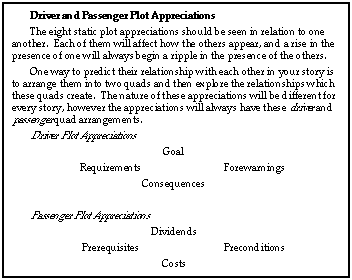Forewarnings appear as a signal that the Consequences are imminent. At first, one might suspect that for a particular Type of Consequences, a certain Type of Forewarnings will always be the most appropriate. Certainly, there are relationships between Forewarnings and Consequences that are so widespread in our culture that they have almost become story law. But in fact, the relationship between Forewarnings and Consequences is just as flexible as that between Requirements and Goal.
Can the Forewarnings be anything at all then? No, and to see why we need look no further than the fact that Consequences and Forewarnings are both Types. They are never Variations, or Elements, or Classes. But, within the realm of Types, which one will be the appropriate Forewarnings for particular Consequences depends upon the impact of other appreciations.
When selecting the Type of Forewarning for your story, think of this appreciation both by itself and also in conjunction with the Consequences. By itself, examine the Types to see which one feels like the area from which you want tension, fear, or stress to flow for your audience and/or characters. Then, in conjunction with the Consequences, determine if you see a way in which this Type of Forewarning might be the harbinger that will herald the imminent approach of the Consequences. If it all fits, use it. If not, you may need to rethink either your selection for Forewarnings or your choice for Consequences.

From the Dramatica Theory Book

